

On the Hill
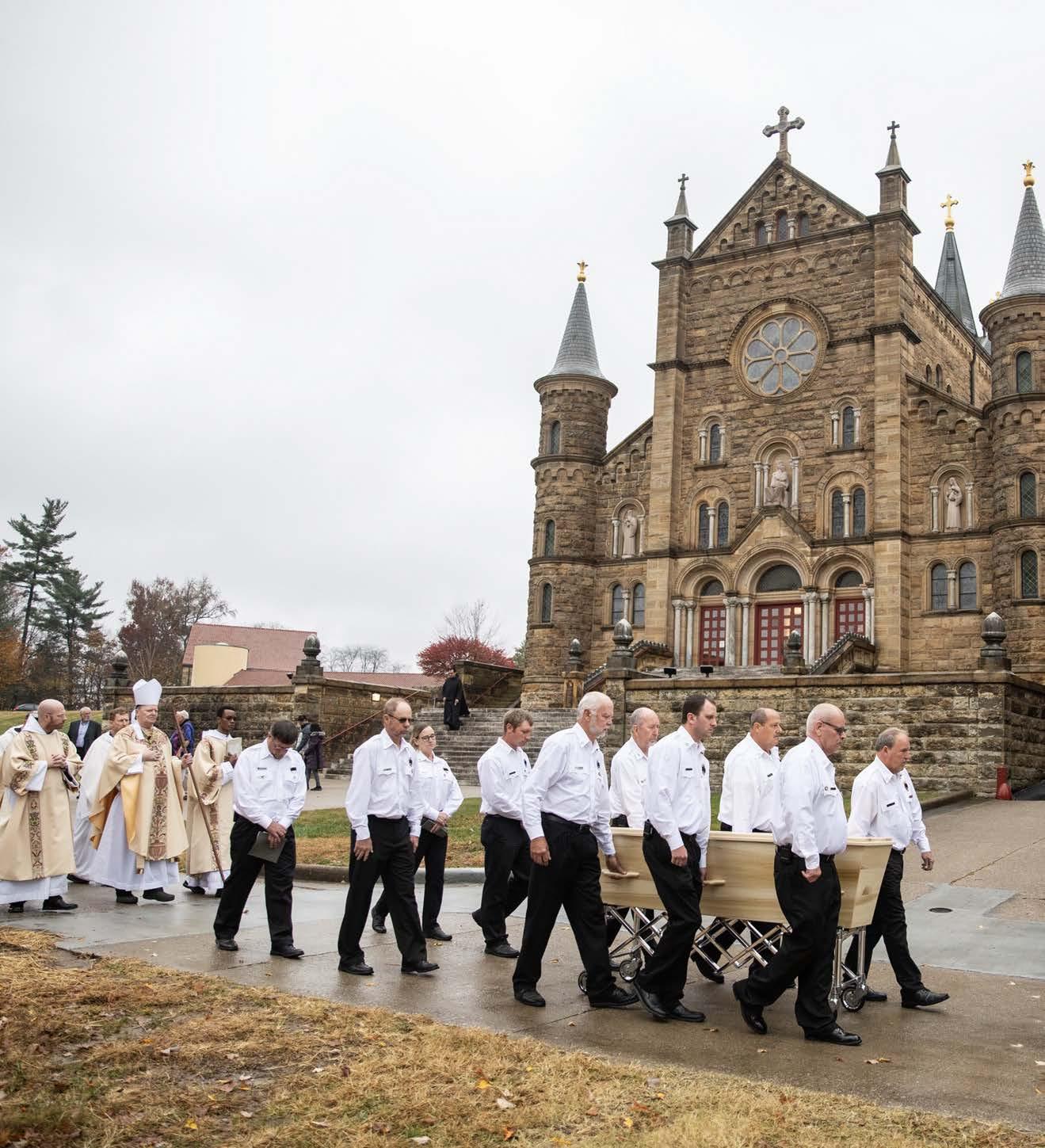

On the Hill
FEATURES
2
3
4-5
.Monks’ Personals
.Br. Giles Mahieu Obituary
On the Hill is published four times a year by Saint Meinrad Archabbey and Seminary and School of Theology. The newsletter is also available online at: www.saintmeinrad.edu/onthehill
Editor:
Copywriters:
Send changes of address and comments to:
Jeanne Schumacher
.Krista Hall & Tammy Schuetter
The Editor, The Development Office, Saint Meinrad Archabbey and Seminary & School of Theology, 200 Hill Drive, St. Meinrad, IN 47577, 812-357-6501 • Fax 812-357-6759, news@saintmeinrad.edu www.saintmeinrad.edu, © 2023, Saint Meinrad Archabbey
Monks’ Personals
Fr. Julian Peters led a retreat for priests of the Diocese of Manchester, NH, on October 3-7. He also led an ordination retreat for deacon candidates and wives of the Diocese of Peoria, IL, on November 3-6.
Fr. Adrian Burke attended the 75th anniversary celebration of the founding of the Carmelite Monastery in Terre Haute, IN, in October. He also gave a talk to the nuns at the Passionist Monastery in Whitesville, KY, on the feast of the Immaculate Conception on December 8.
Br. Stanley Rother Wagner gave a lecture titled “A Brief History of Saint Meinrad Archabbey: A Benedictine Monastery in an American Context” on October 21 in Dr. Katharine Harmon’s American Church History course at Marian University in Indianapolis. He also gave a lecture titled “The Liturgical Movement & Renewal: Actual
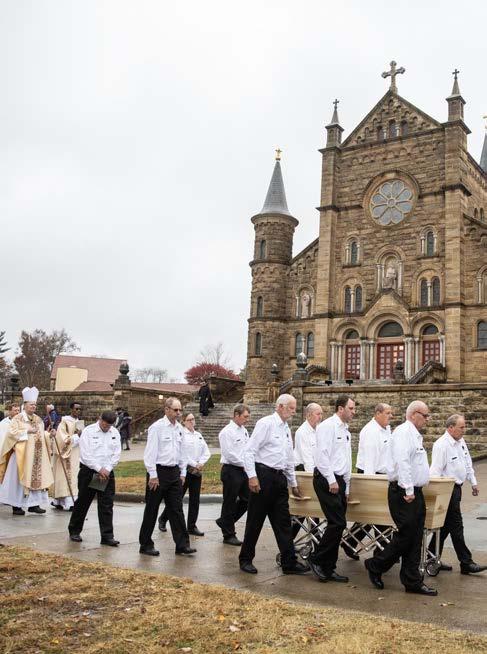
St. Meinrad volunteer firefighters carry the casket of Br. Giles Mahieu, OSB, to the Archabbey Cemetery on October 31. Find more photos at http://saint-meinrad.smugmug.com
Participation and Hospitality for Social Regeneration in the Twenty-first Century” at Marquette University’s Gesu Church in Milwaukee on November 6.
Fr. Harry Hagan published Elements of Biblical Poetry: An Introductin to Its Craft, Language, and Genres with PALNI Press. He also completed the revision of the Saint Meinrad translation of the Rule of St. Benedict. He gave two Advent Conferences at St. Isidore and St. Martin parishes. He showed pictures and talked about the way that the Nativity appears in western art.
Fr. Simon Herrmann met with several parishes and school groups in the Muncie, IN, pastorate and gave presentations on monastic life and lectio divina from September 27-October 1. He also gave information to Ball State University students about the “One Bread, One Cup” internship. Fr. Simon presented on
“Benedictine Spirituality for Young Adults” to the young adults of the Diocese of Charleston at the Diakonia Retreat Center in Salem, SC, on November 4-6.
Fr. Anthony Vinson attended the National Council of Catholic Women Convention in Minneapolis, MN, at the end of October. Fr. Anthony serves as the chair of the board for National Funds for Catholic Religious Vocations.
Br. James Jensen, Fr. Simon Herrmann and Fr. Nathaniel Szidik worked at the Saint Meinrad booth at the SEEK Conference in St. Louis, MO, on January 2-6.

fireman and jubilarian, dies October 25 Br. Giles Mahieu,
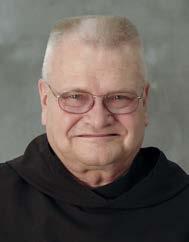
Br. Giles Mahieu, OSB, a monk of Saint Meinrad Archabbey, died at Gateway Deaconess Hospital in Evansville, IN, on Tuesday, October 25, 2022. He was 84 and a jubilarian of monastic profession.
Surviving are a brother, Lawrence of Davenport, IA; and four sisters, Susan Polton of Davenport, IA; Kathleen Kelly of Bloomington-Normal, IL; Marcella Johnson of Port Byron, IL; and Dr. Patricia Mahieu of Stow, OH.
Born in Moline, Illinois, on July 3, 1938, Br. Giles was the oldest of the 10 children of Albert J. and Lorraine (Kruger) Mahieu. He was given the name Robert at his baptism. He attended one year of Alleman High in Rock Island, IL, before
entering Saint Meinrad’s St. Placid Hall in 1956 as a sophomore.
He was invested as a novice on April 7, 1957, and professed his simple temporary vows on April 16 the following year. He professed simple perpetual vows on April 16, 1961, and solemnized his religious profession on July 11, 1973.
Br. Giles’ early assignments included a 10-year stint in the bakery and nine years in the electrical department. He also joined the Saint Meinrad Volunteer Fire Department, where he served for more than 40 years. For 22 years, he served as chaplain for the 18th District of the Indiana Volunteer Fireman’s Association, and he was secretary-treasurer of the Spencer County Fire Chiefs’ Association for 33 years. In 2001 he was named Spencer County’s Firefighter of the Year.
In the early 1970s, he was installed as a lector and assisted the pastors for several years at St. John Chrysostom Parish in
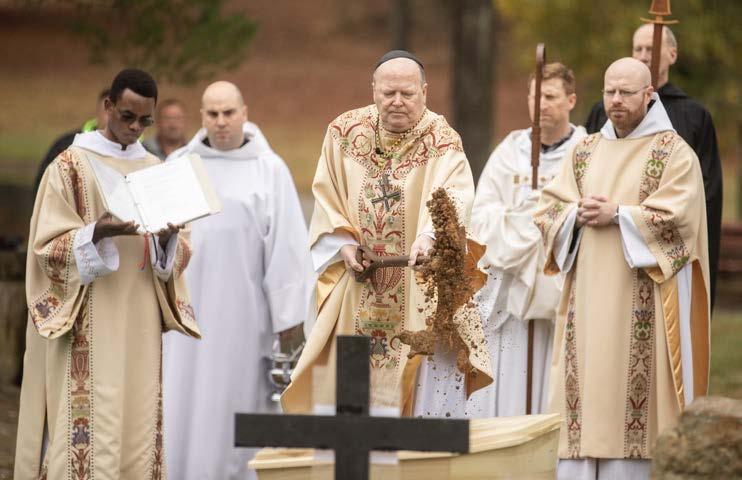
New Boston and at St. Martin’s Parish, Siberia, both in Indiana.
Br. Giles was appointed Saint Meinrad’s director of sanitation in 1975 and, in 1976, was certified by Purdue University as a licensed pesticide operator and applicator. He served on the board of directors of the Indiana Pest Control Association for eight years, including a term as its president.
In addition, Br. Giles enjoyed directing traffic at the May and October pilgrimages at the Monte Cassino Shrine and serving as a cooperative observer for the central region of the National Weather Service. He was especially fond of trains and over the years assembled an elaborate model railroad display, complete with landscapes, road crossings, and villages, which he eventually donated to the Dubois County Museum in Jasper, IN.
The funeral was held on October 31, with burial in the Archabbey Cemetery following.
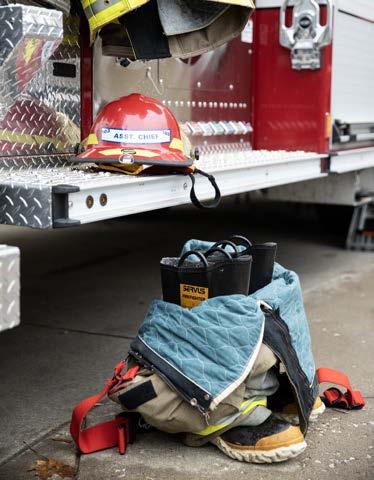
Br. Giles Mahieu
Left: Archabbot Kurt Stasiak, OSB, pours a shovel of dirt on the casket during the burial for Br. Giles Mahieu, OSB, in the Archabbey Cemetery. Right: Br. Giles’ fire gear was displayed on a fire truck along the procession path to the cemetery. Br. Giles served more than 40 years on the St.
Meinrad Volunteer Fire Department. In 2021, he was named Spencer County’s Firefighter of the Year.
CHAPTER ROOM: The Art of Monastic Life

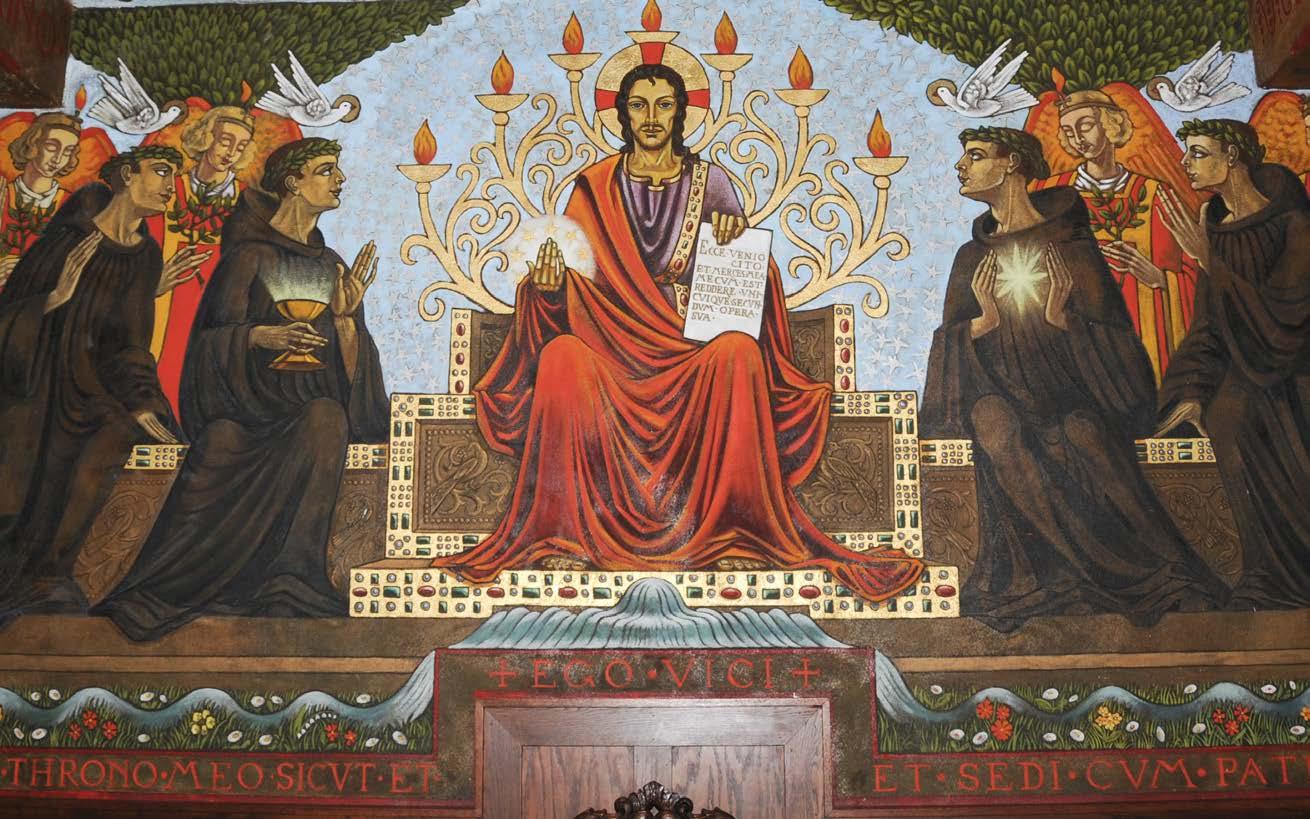
Editor’s note: The Chapter Room is usually open for visitors, but is temporarily closed while St. Anselm Hall undergoes renovation. It is expected to reopen by the fall.
Visitors to Saint Meinrad typically enjoy the artwork found in the buildings and on the grounds, but the Chapter Room stands alone for its sheer amount and variety of art.
The Chapter Room is a special room in a monastic community. It’s where the business of the monastic family takes place – meetings, spiritual talks, official reports. At Saint Meinrad, the Chapter Room is off of the second floor of St. Anselm Hall, which was the monastery until a new one was built in the 1980s.
For the first 30 years, the Chapter Room was a plain, rectangular room. Then Abbot Ignatius Esser, OSB, commissioned an artist monk from the Abbey of Mont César in Belgium to decorate the space. The project took about six months, and it was dedicated on March 21, 1943.
The artist was Fr. Gregory de Wit, whose work also can be found in the Archabbey Church (the Christus on the east wall) and
Memorial Lobby (murals of St. Benedict and St. Meinrad).
When visitors tour the Chapter Room, they enter through the room’s only door and walk into a room filled with meaning and art.
If These Walls Could Talk
The walls feature images depicting passages from the Rule of St. Benedict. In one scene, a monk is seated on a bench with an open book on his lap. He holds a finger to his lips. The Latin text around the image is: Multum loqui non amare, which translates as “not to love much speaking,” or “prefer moderation in speech.” This is taken from Chapter 4 of the Rule
Another painting by Fr. Gregory shows a poor shepherd at the door to the monastery. One of the monks is kissing his feet while another is setting a bowl of soup on the table for the man to share with them. If you look closely, you’ll see the
visitor has a halo around his head with a cross in it: a sign of Christ.
St. Benedict wanted his monks to see Christ in everyone and receive all guests as if they were Christ. The text from the Rule says: “Because in the poor, Christ is more especially received.”
A Window into Monastic Life
Between the various paintings on the wall are 24 windows, grouped in pairs, with six pairs on opposite sides of the room. Here, Fr. Gregory sought to evoke the meaning of the monastic vocation.
Each window features a Latin word or phrase. In the first window, you can see the word Ausculta, which is the first word of the Rule – listen. The window also contains a giant ear, a baby bird and an adult bird. The young bird stands with mouth open wide, eager to receive the food the parent is about to provide. The inference is that the viewer should be as eager to hear the Word of God.
The windows follow an old rule of church decoration: when the walls are colored, the windows are not. These windows are made of clear glass, tinged with a greenish gray hue. All the letters and figures are made of heavy lines in plain black.
Look Up for a Scripture Story
The most colorful and lively art was painted on the ceiling, where Fr. Gregory depicted scenes from the canticle of the three children, from the Book of Daniel. Each of the six center panels illustrates part of the story. Alongside each painting is a corresponding verse.
For example, on the panel illustrating the plants and fish of the sea are the Latin words for “You dolphins and all water creatures, bless the Lord.”
Alongside these panels are 12 smaller panels on which the artist has painted the symbols of the Zodiac, along with their names and constellations.
A Mural of Revelation
Dominating the back wall of the Chapter Room is a mural, featuring Christ in the center sitting on a throne. In his right hand, Christ holds the seven stars mentioned in the Book of Revelation. In his left hand is a document with Latin words that translate as: “Behold I come quickly, and my reward is with me, to render to each one according to his works.”
On each side of Christ are five monks, walking toward Him and preparing to receive their heavenly reward. Below Christ’s throne is a stream of living water
that gushes forth and runs along the mural to the right and left.
Beside each monk is the guardian angel who accompanied him through life. Above each head is the dove or spirit who served as a guide. Laurel wreaths have been formed by the angels and placed on the heads of the monks.
These Monks Guard the Entrance
As you turn back toward the entrance, two large wood-carved figures of monks flank the doorway. Across the shoulders of these eight-foot monks is a large, gilded beam that spans the top of the doorway, carved with the words Jugum Stae Regulae – Yoke of the Holy Rule. This refers to the Rule of St. Benedict.
One monk holds a bowl of holy water and the other holds a cross. These monks were carved by Br. Herman Zwerger, a monk of Saint Meinrad, following the clay models made by Fr. Gregory.
A (Paint)Brush with Death
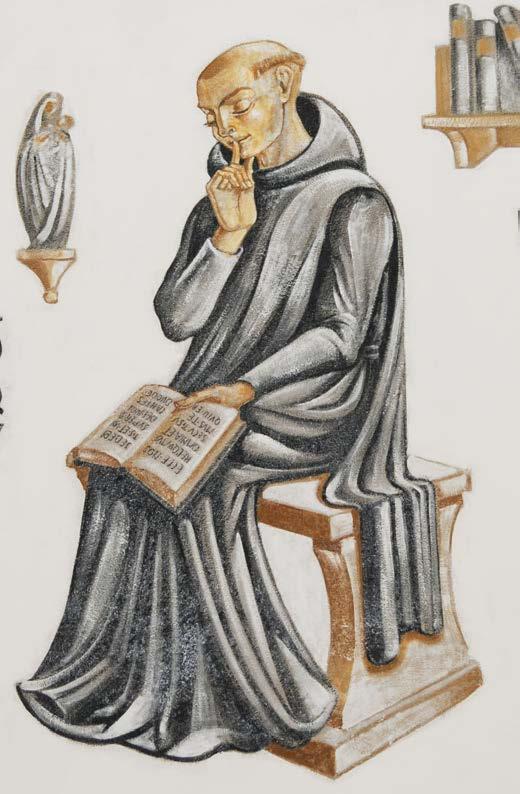
As you leave the Chapter Room, you’ll notice two paintings that illustrate death are found above the entrance.
On one side is depicted the dying moments of St. Benedict. Just before he died, he commanded his monks to carry him into the oratory, where he could receive Communion. With his hands lifted up to heaven in prayer, he gave his last breath.
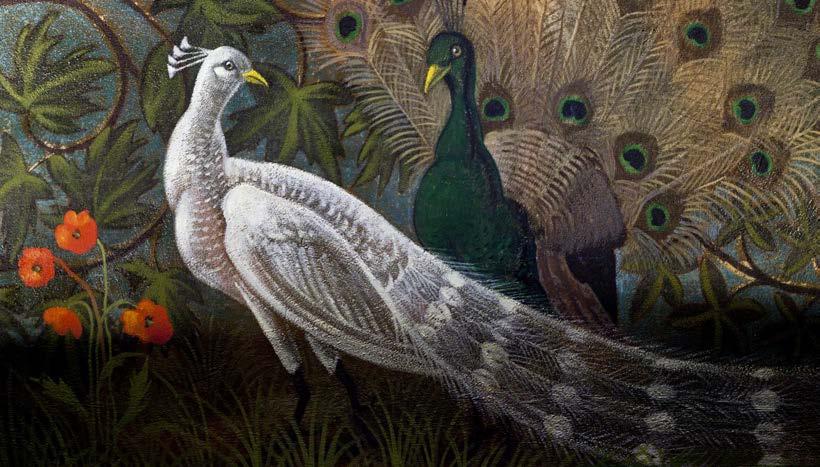
In the second painting, the monks are reminded by St. Benedict “to keep death daily before one’s eyes.” In this piece, a monk on his deathbed is surrounded by his confreres. One of the monks holds a copy of the dying man’s vow chart, signed at the time of his profession.
The monk seems to be reaching up toward heaven. The hand of God is reaching down and the Latin words for “Well done, good servant” are etched into the ray from heaven.
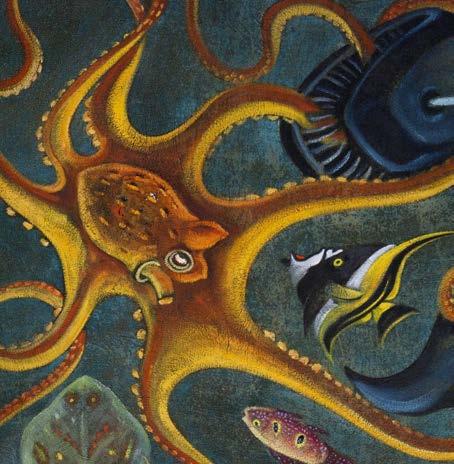
Young Adult Initiative enters Phase 2 with successful gathering
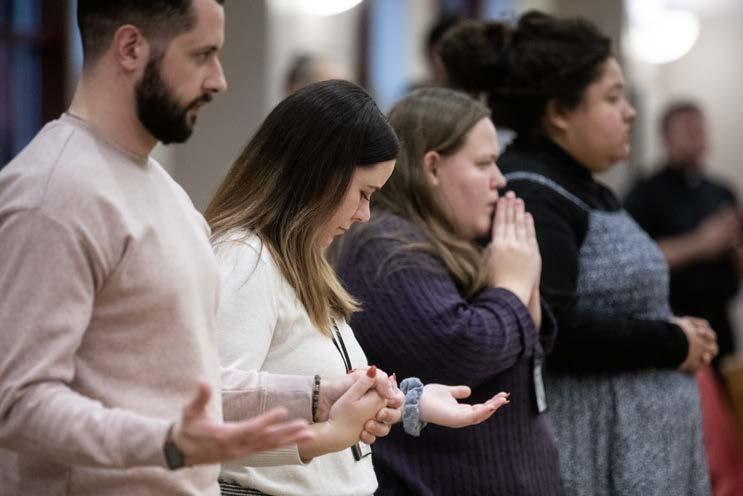
The Young Adult Initiative, a program of Saint Meinrad’s Center for Youth and Young Adult Evangelization, hosted its first gathering for Phase 2 of the initiative on November 4-6. The gathering is a semi-annual meeting of partner parish representatives from the 10 participating Midwest parishes; 28 participants attended the fall event.
YAI Director Cassie Schutzer said the weekend had five goals: to be fully present, to establish the Young Adult Initiative community, to encounter the spirit of Saint Meinrad, to share experiences, and to return home to the parishes with something to share.
OTopics included the domestic church, tradition and living liturgically, prayer, belonging, accompaniment, mentoring/ modeling, and intentionality.
Instead of just telling participants how to minister with young adults in their parish, the YAI staff invited them into the process by modeling ministry for them. The weekend was filled with community prayer, small group reflection/ conversation, and activities they could bring to their parish.
When asked, “What was your favorite part of the weekend,” 65% of participants mentioned the opportunities for fellowship and conversation. When asked, “Will you
return for another gathering,” 100% responded yes.
Various members of the Saint Meinrad community assisted with the event. President-Rector Fr. Denis Robinson, OSB, led prayer and gave words of encouragement; Sr. Jeana Visel, OSB, welcomed the group and attended several sessions; Agnes Kovacs gave the keynote presentation; and Br. John Mark Falkenhain, OSB, led a campus tour.
In addition, seminarians Deacon Neil Blatchford and Bobby Vogel served at Mass; Nolan Snyder provided music for Mass and Adoration; seminarian Patrick Gouker cantored at Mass; and other students were welcoming and hospitable at the UnStable social.
Parishes in YAI Phase 2 are: St. Clare of Assisi Parish, O’Fallon, IL; Cathedral of St. Peter, Belleville, IL; St. John the Evangelist Parish, St. John, IN; St. Matthias Parish, Crown Point, IN; Mary, Queen of the Holy Rosary Parish and Pax Christi Catholic Church, both of Lexington, KY.
Most Sacred Heart of Jesus Cathedral Parish, Knoxville, TN; St. Patrick Parish, Morristown, TN; and St. Joseph Catholic Church and Holy Spirit Parish, both of Bowling Green, KY.
Anyone interested in keeping up with the activities of the YAI can subscribe to the e-newsletter at https://saintmeinradyai.org/ contact/.
ur first gathering was filled with moments of encounter with the Lord and with one another. We had one participant remark that is was the first time he felt like he belonged somewhere; two of our participants got engaged during the weekend; one young man began discerning a call to religious life; and 100% of our participants said they can't wait to come back to the Hill for another gathering. The Lord was certainly at work among us!”
—Cassie Schutzer Director, Young Adult Initiative
Sarah Daubach, second from left, prays the Lord’s Prayer at Mass in the St. Theodore Guerin Chapel during the Young Adult Initiative’s first gathering for Phase 2 on November 5.
New Director of Center for Youth and Young Adult Evangelization named at Saint Meinrad
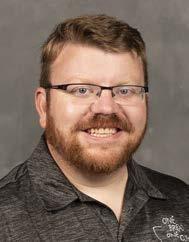
Scotty Biggs of Greensburg, IN, has been named the director of Saint Meinrad’s Center for Youth and Young Adult Evangelization. He began his work on December 6.
In this position, Biggs provides vision and oversight for the programs and activities of the Center, including the “One Bread, One Cup” high school conferences and college internship, the Young Adult Initiative, and the Office for Hispanic and Latino Ministry.
Biggs holds a bachelor’s degree in history from Eastern Kentucky University and a certificate in spiritual direction from Our Lady of Grace Monastery. He is currently
working toward a master’s degree in theology from Saint Meinrad Seminary and School of Theology.
Most recently, Biggs has been a diocesan missionary for the Batesville Deanery in the Archdiocese of Indianapolis. He has also been the coordinator of youth and young adult ministry at St. Bartholomew Catholic Church in Columbus, IN.
Prior to that, he worked at the parish as the director of youth ministry and Confirmation prep. From 2013-14, he worked for the Capuchin Youth and Family Ministry. He is also a writer and content developer for Sadlier Publishing Co.
Biggs also has taught liturgical arts at the “One Bread, One Cup” youth conferences, which is a program of the Center for Youth and Young Adult Evangelization at Saint Meinrad Seminary and School of Theology.
Free guide aims to welcome international priests
The Institute for Priests and Presbyterates (IPP) has released a free guide, Making Welcome: Preparing to Receive an International Priest, for use by dioceses and parishes. The guide offers practical considerations when receiving an international priest.
International priests serving in the United States bring many gifts and talents to their ministry, but also face distinct challenges. Saint Meinrad’s IPP has worked with international priests for over 15 years through workshops that assist them in their transition into diocesan ministry in the U.S.
“We’ve heard many accounts of international priests’ transitions – what’s
been good and helpful as well as what’s been difficult, unsuccessful or even overlooked,” says Fr. Julian Peters, OSB, director of the Institute for Priests and Presbyterates.
Making Welcome combines broad principles from the U.S. Conference of Catholic Bishops’ document, Guidelines for Receiving Pastoral Ministers in the United States, with concrete and practical suggestions on how the diocese and local parish can work together to create a positive experience for the priest as well as the parish.
The free resource is available to download at: www.saintmeinrad.edu/makingwelcome.
February 9
Fr. Cyprian Davis Lecture, 7 p.m., Deanna Witkowski will be the speaker
February 10-12
Guest House Retreat: “Welcoming InLaws” by Fr. Noël Mueller, OSB. (Valentine’s Retreat – married couples only)
February 28-March 2
Guest House Workshop: “Freedom Through Forgiveness” by Br. Zachary Wilberding, OSB
March 17-19
Guest House Retreat: “Christian Hospitality: Welcoming One Another as Christ” by Fr. Adrian Burke, OSB
March 23
Thomas Lecture, 7 p.m., speaker to be announced
March 24-26
Guest House Retreat: “Welcoming InLaws” by Fr. Noël Mueller, OSB. (Second Valentine’s Retreat – married couples only)
April 5-9
Guest House Retreat: “Celebrating the Paschal Mystery” by Fr. Noël Mueller, OSB
April 17-21
Guest House Workshop: “The Sermon on the Mount: Matthew’s Handbook for Living in the Kingdom of Heaven” by Fr. Eugene Hensell, OSB (Priests Retreat)
May
Rosary pilgrimage at Monte Cassino Shrine each Sunday at 2 p.m. Central
May 19-21
Guest House Retreat: “Contemplative Christianity: God’s Call to Holiness” by Fr. Adrian Burke, OSB
June 9-11
Guest House Retreat: “Unpacking the Vocation of Marriage through Scripture and Married Saints” by Josh and Angie Greulich (married couples only)
For more information, call 812-357-6611 or visit our website www.saintmeinrad.org
Scotty Biggs
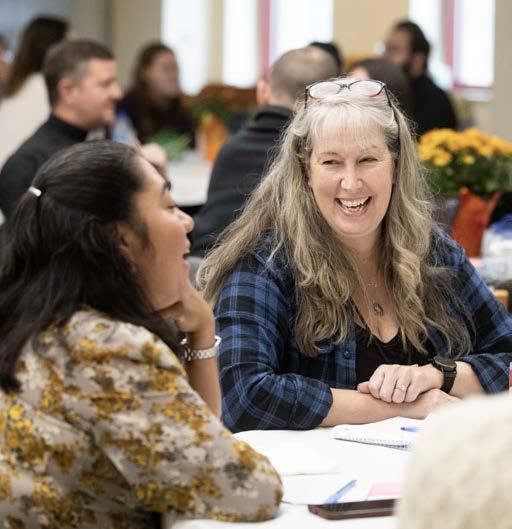
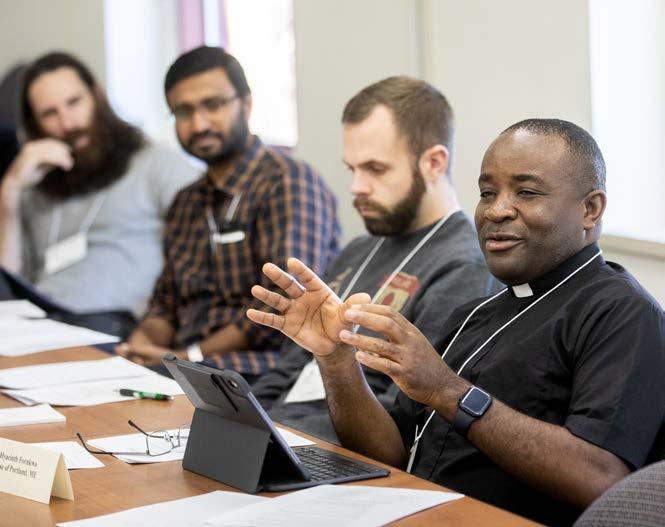
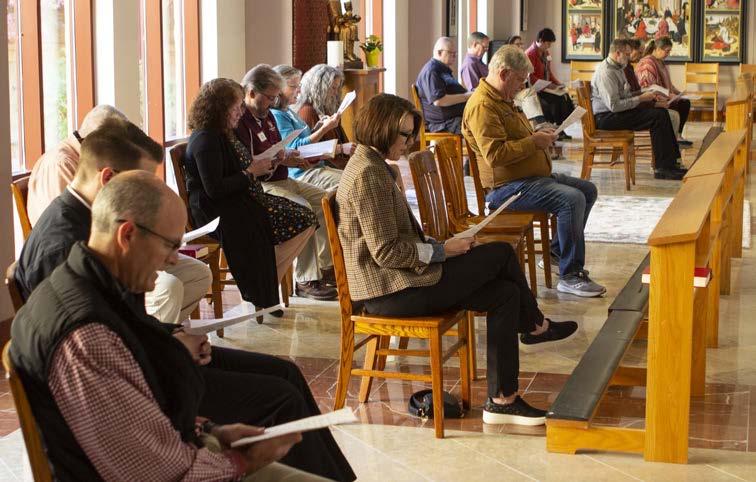

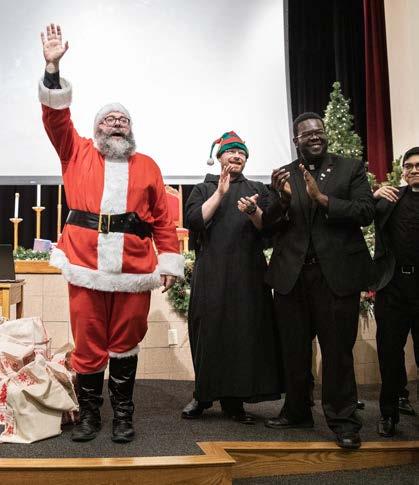
Photos, from top, left to right: Veronica Hernandez, left, and Colleen Jacobs participate in a group discussion during the Young Adult Initiative gathering on November 5 in St. Bede Hall.
Fr. Hyacinth Fornkwa of the Diocese of Portland, ME, discusses situations around borrowing priests from other dioceses and countries during a session on canonical considerations and responsibilities led by Msgr. Fred Easton on November 9 of the Institute for Priests and Presbyterate’s Newly Appointed Pastor Program.
Graduate Theology students attend Morning Prayer in the St. Theodore Guerin Chapel before weekend courses began on October 15.
Members of the fourth-year theology class wish classmates, faculty members, staff and their families a Merry Christmas at the end of the annual St. Nicholas Banquet in the St. Bede Theater on November 29.
Deacon Jack Wright carves a pumpkin to look like a prison during the pumpkin carving house challenge in October.
[Meet the Student]
Caleb Scherzinger
Diocese: Diocese of Evansville
Hometown: Celestine, IN
Q. What attracted you to the priesthood?
For me, one of the biggest attractions to the priesthood was helping others on their journey to encounter Christ. I find that accompanying others as they encounter Christ and grow in a life of faith is fulfilling. Within the role of the priesthood, I mainly see that in the sacraments of reconciliation and the Eucharist.
I find that an essential part of walking with people is healing. One of the most healing aspects of our faith is being able to forgive and be forgiven. In this forgiveness, we can see the love and mercy God shows each of us. The sacrament of the Eucharist is a source of strength for journeying in the world. As a future priest, I see my role in accompanying as being able to bring these sacraments to those on their journey with Christ.
Q. Who or what influenced you to begin study for the priesthood?
There are two important people who influenced my vocation. The first was my pastor in high school, Fr. Eugene Schmitt. Fr. Eugene showed me what it means to be a good and holy priest. He was present to those in the community – whether at high school sporting events or to a family whose loved one is in the hospital. He also was a prayerful and gentle priest. When working with others, he is there to listen and hear people and their struggles, taking those struggles and concerns into consideration when making a decision.
The second person who influenced my vocation was Fr. Jerry Pratt. I met Fr. Jerry
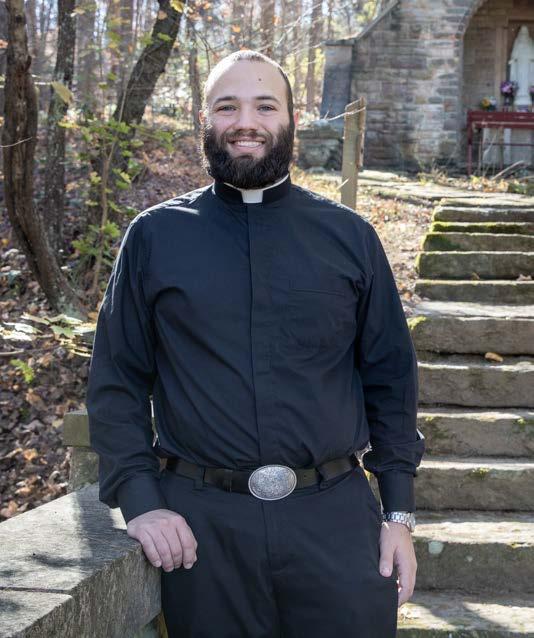
in college at the University of Southern Indiana. Fr. Jerry helped me with my vocational discernment. He was there to listen to my concerns about discerning priestly vocation. He also encouraged me to pursue this vocation by inviting me to the Hill and giving me other opportunities to see what the vocation of priesthood is and how I could see myself in that role.
Q. What were you doing before you came to the seminary?
I studied accounting at the University of Southern Indiana in Evansville. Upon graduation, I entered the seminary at Saint Meinrad.
Q. Favorite saint and why?
My favorite saint is St. Francis de Sales because he embodies spiritual accompaniment. In his writing, he consoles others on their spiritual journey. I feel that his insight shows us how we can accompany others on their faith journey.
Q. Favorite Scripture verse and why?
Proverbs 12:27: “A slothful man will not catch his prey, but the diligent man will get precious wealth.” This passage speaks to me in that one of my favorite pastimes is hunting. Another reason this verse speaks to me is because of the idea that if you desire something, you need to put in the time to acquire it. Sometimes we want things but do not want to do the work. This verse motivates me to do the work necessary to achieve my goals in life and ministry.
Q. Hobbies?
My hobbies are hunting, reading and gardening/potted plants.
Q. What aspect of seminary life has been most rewarding?
One of the most rewarding parts of seminary is the ability to understand better who I am. One buzz phrase around seminary is “self-knowledge, selfacceptance and self-gift.” I find that one of the great rewards of seminary is being able to take the time to explore these three categories to serve others better, based on who I am as a person. The intention in seminary is to understand these categories and function in a way that allows you to work in God’s plan. Understanding this role has allowed me to serve others in ministry better.
Q. Best advice you’ve heard in seminary?
The best advice I have heard in seminary is, “You get out of seminary what you put into it.” One of the things about seminary is that formation requires that for one to grow, he has to choose to grow. In this understanding, it is important to realize that if I do not want to do something, I do not have to do it. Though, if I don’t, I may be doing a disservice to myself and those in my future ministry – and miss out on an opportunity to grow in some aspect of my life.
New year of preparation added to seminary studies Propaedeutic


As a freshman at Purdue University, Chase LaCoursiere was studying computer engineering and living his Catholic faith in name only. During the Covid years when many activities were canceled, he decided to dive deeper into his faith.
“I started reading things about the faith, and I kind of fell in love with that ... I would rush to get done with my computer engineering homework so that I could go read theology and philosophy,” Chase recalls.
As he got closer to earning his degree, he also realized that he had no real passion for computer engineering. He could do the work, but he didn’t have the desire he saw in his classmates.
That led Chase to continue his study of philosophy and theology. He affiliated with the Archdiocese of Indianapolis to study for the priesthood and learned he would be one of the 10 men attending Saint Meinrad’s first class of propaedeutic studies.
In some ways, Chase is the typical
propaedeutic student: as a noncollege-seminary student, he did not formally study theology or philosophy and was not part of a community with a spiritual focus.
“I enjoy the Catholic community here,” he says. “We’re all moving in roughly the same direction.” He appreciates the structure of the program, but also the free time. “I have plenty of time to do my reading that I like to do, in a great library where I can essentially go get any book I could ever want.”
A team of formation staff, instructors and faculty is piloting the propaedeutic year, which Saint Meinrad calls El Camino. “We wanted it to be viewed as a way of pilgrimage,” explains Dr. John Schlachter, academic coordinator for the propaedeutic year. “The participants would be on a spiritual pilgrimage throughout the year, learning more about themselves, their dioceses, and the Universal Church.”
The focus of the year is on spiritual and human formation, but El Camino includes some academics and ministry opportunities as well. Special days of
recollection and rest are built into the schedule to give the men time to digest what they’re learning and reflect on their experiences, Schlachter explains. At the end of the year, there is a six-day walking pilgrimage to Santiago de Compostela.
“We have built into our program seminarstyle sessions, where ideas are the main focus, and then they get a chance to put those ideas together in practice, in their prayer lives, and in their ‘Habits of Priestly Spirituality’ session,” he says. In those sessions, the instructor introduces concepts or practices of priestly formation and provides space for the students to talk about them and how they might be incorporated into their lives.
Fr. Luke Waugh, OSB, serves as the formation dean for the class, meeting with them weekly to see how their classes are going, answer any questions they have, and observe how well they are integrating the information they’re learning.
The students range in age from 21 to 31, Fr. Luke says. “Some of them are coming from jobs and careers,” with educational
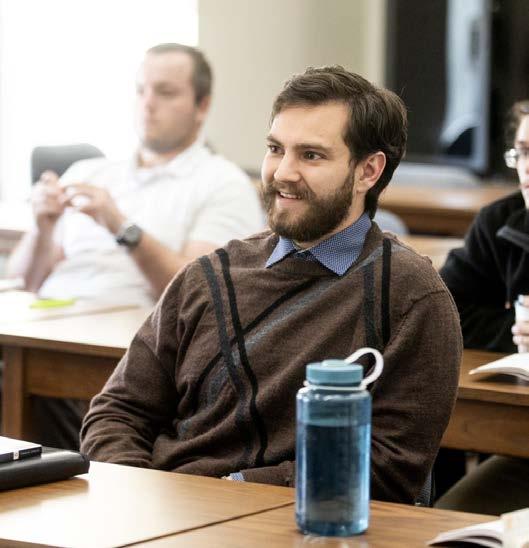




backgrounds ranging from theology to STEM (science, technology, engineering and math) degrees, like Chase. “There are several who have not been active in the Church for very long.”
To help the students come together as a community, they are housed on the same floor. They have their own dining room for meals and a separate chapel for daily Mass and prayer. On some days, they join the regular seminarian community for meals and Mass. They’ve also enjoyed some group social activities, such as a pitch-in dinner.
Although he admits to being skeptical at first about the need for a propaedeutic year, Fr. Luke is quickly seeing the benefits for the students. “They’ve had time to focus on the human formation and the spiritual formation, in obtaining the tools of discernment – without the pressures of an academic component on top of it,” he says.
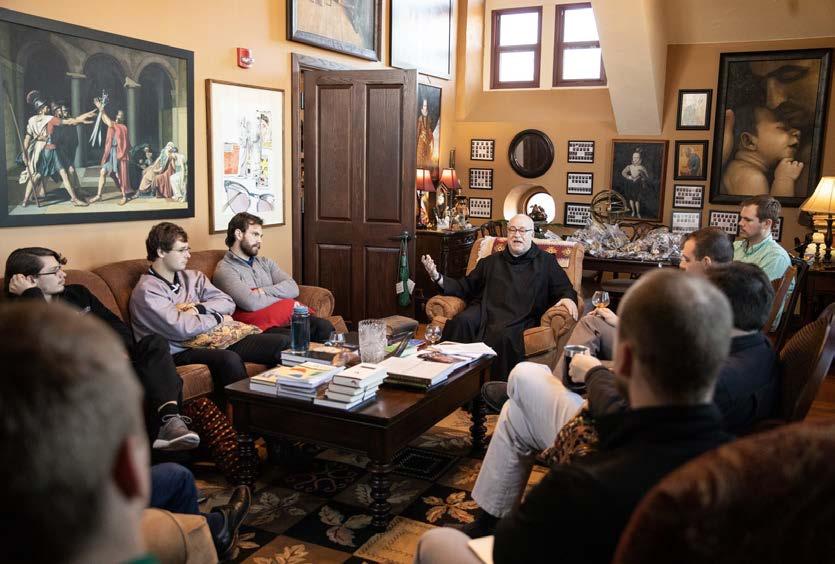


to use the breviary for daily prayer. At the beginning, some of the men needed help in figuring out the breviary, so Wilebski held an impromptu lesson on how to pray the Liturgy of the Hours.
Also a member of the propaedeutic year team is Deacon John Wilebski. A transitional deacon in his final year of priesthood studies, Wilebski lives on the same floor with the propaedeutic students. As a seminarian further along the path to ordination, he can be a mentor and offer advice from his own experience.
For example, he’s a good resource for the practical questions that arise, such as how
During the first weeks of the new program, Wilebski has watched the men bond as a group. “Probably the strongest aspect of the program so far, with this particular group of men, is the community that they’ve been able to form with each other,” he says. That sense of community is forming them as well.
Wilebski believes the propaedeutic year allows these men to step away from their normal patterns outside of seminary.
“Because of that, it’s bringing more
What is a Propaedeutic Year?
A major change to how priesthood formation takes place is under way in the United States.
In revising the document that seminaries follow, Program of Priestly Formation, the U.S. bishops decided in 2022 to add another year of formation “to provide seminarians with the basic groundwork they need to engage in priestly formation” (PPF, 119).
Typically, a student who did not attend a college seminary took two years of philosophy before attending the fouryear theology program. Now, another
year of formation has been added, called the propaedeutic year.
The propaedeutic year is a preparatory year, where the primary focus is on human and spiritual formation, along with gaining some tools and time for discernment. The men live together in community, separate from the other men studying for priesthood.
At Saint Meinrad, a formation dean and a house prefect are assigned to the propaedeutic seminarians. For the 2022-23 year, 10 men enrolled in the first propaedeutic class. �
clarity and discernment for them,” he says. “They’re discovering more of themselves that they maybe didn’t realize was there.”
Saint Meinrad offers lots of resources for the propaedeutic year, according to Wilebski, from spiritual direction and counseling to opportunities to visit parishes that reflect the diversity of the Catholic faith. “So while the big picture is oriented toward priesthood, they’re very much working on themselves and their relationship with God in this year.” �
Typical Day
Here is a typical schedule for the propaedeutic students:
Breakfast
Morning Prayer
Formation Session: Various speakers on Habits of Priestly Spirituality
Mass
Lunch
Language Class
Seminar: Various speakers on topics within Catechism or Western
Traditions
Free Time
Vespers
Dinner
On Wednesdays, students meet with their house dean in the morning, followed by a formation session on Serving the Common Good. They take part in supervised ministry in the afternoon.
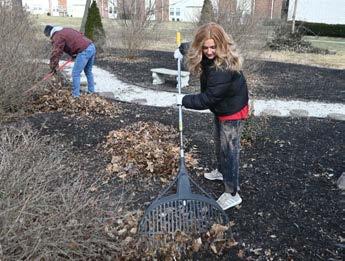
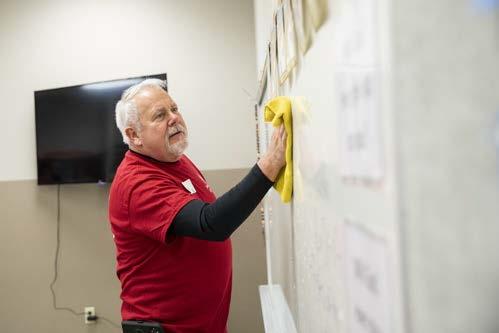
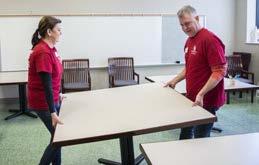
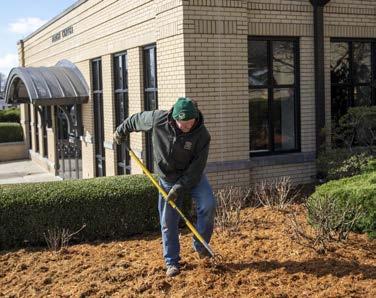

Day of Service: Projects set for March 11
Locations and projects are coming together for the nineth annual Saint Meinrad Day of Service. This year, the day of service will be Saturday, March 11.
The event, organized by the Saint Meinrad Alumni Office in partnership with alumni around the country, is open to any participants, not just alumni.
“The Day of Service is about coming together to bring the Benedictine spirit of Saint Meinrad into our own communities by praying for and serving others,” says Tim Florian, Saint Meinrad’s director of alumni relations.
The Saint Meinrad Day of Service seeks to serve in the local communities of alumni and friends all over the country. Currently, 14 projects will be hosted in 12 cities, with the hope of adding more to the list.
Since its inaugural year in 2014, the day’s theme has been Ora et Labora, Pray and Work. Along with the service activities, prayer is planned into the day through celebrating Mass or praying the Liturgy of the Hours, including a special prayer written by Archabbot Kurt Stasiak, OSB.
For more details about projects in your area and to register as a participant, visit the Saint Meinrad Day of Service event page at: https://alumni.saintmeinrad.edu/ home/day-of-service/. Be sure to check back for updates.
There is no cost to participate, and each volunteer receives a free Saint Meinrad Day of Service t-shirt, courtesy of the Saint Meinrad Alumni Association.
Volunteers are asked to register by March 2 to ensure an accurate count for
those planning the project. If you have any questions about the Day of Service, contact the Alumni Office at 812-3576501 or email Tim Florian at tflorian@saintmeinrad.edu.
2023 Locations:
Alexandria, LA
Bloomington, IN
Copley, OH
Denver, CO
Evansville, IN
Indianapolis, IN
Kankakee, IL
Louisville, KY
New Albany, IN
Los Angeles, CA
Toledo, OH
Tulsa, OK
Check the website for the complete list.
Noteworthy:
Newsworthy items about Saint Meinrad people and events

Dr. Dan Kolb, Saint Meinrad’s library director, has received an award from the Private Academic Library Network of Indiana (PALNI). PALNI is a nonprofit organization supporting collaboration for library and information services for 24 private academic institutions throughout Indiana.
In August, Kolb received the Lifetime Visionary Award for leadership in deep collaboration. This award honors those in PALNI who have articulated the nature of the changing information services landscape and provided long-

standing leadership to work together to meet those needs.
It’s not every day you get to meet the pope. But Tania Vergara-Gongora, a high school senior from Louisville, KY, joined 11 other Catholic youth who met with Pope Francis in Rome on October 12. She is a former participant in Saint Meinrad’s “One Bread, One Cup” liturgical leadership conference.
At the meeting with the pope, she gave him a written message, a prayer card and a friendship bracelet. Vergara-Gongora was part of a delegation representing the National Youth Advisory Council, of the National Federation of Catholic Youth Ministry.
Deb Dyko, liturgical music director and organist for Saint Meinrad Seminary and School of Theology, won the 2022 Emerging Composer Competition sponsored by the Canticle Singers of Baltimore.
Her piece, The Vision of the Night Sentry, was performed by the Canticle Singers on December 2, and then two days later at Saint Meinrad’s “Lessons and Carols” service. This was the first year for the competition, with 52 entries received from U.S. and international musicians.
Archabbey Library offers alumni additional free resources
The Saint Meinrad Archabbey Library has added free access to alumni for two more online resources.
The first is a collection of electronic books and journals from Project MUSE. The book collection includes more than 33,000 recent titles in the humanities, with thousands of titles in theology, philosophy, Church history, and related subjects. Books are easily downloaded by chapters in PDF format.
The journals available in Project MUSE include titles such as The Thomist, Nova et Vetera, U.S. Catholic Historian, and The Journal of Early Church Studies.
The second new resource is the online edition of The New Catholic Encyclopedia and its supplements. These 26 volumes feature more than 12,000 entries on theology, philosophy, history, literary figures, saints, musicians, scripture, Church history, and more.
These resources are in addition to continuing access to online journal articles and books in the humanities through JSTOR and articles covering all aspects of theology, religion, and related fields through AtlaSerials Plus.
Alumni can get access to these library resources at the Library Resources page on the Saint Meinrad Alumni website, alumni.saintmeinrad.edu.
The Archabbey Library also offers alumni document delivery service, scanning and sending journal articles and book chapters that are not available through one of the sources mentioned above.
You can discover available resources through the Library Catalog (https://saintmeinrad.on.worldcat.org/adva ncedsearch) and request scanned documents through the links on the Library Resources page on the Alumni
website. For help with accessing library resources, email library@saintmeinrad.edu or call 800-987-7311.
From the alumni website, the link to library resources is https://alumni.saint meinrad.edu/resources/library-resources/
More Benefits
Alumni also have access to various other benefits, such as:
•Access to the Saint Meinrad Alumni Directory at https://alumni.saint meinrad.edu/directory/
•10% off books and 15% off gifts at the Scholar Shop and the Saint Meinrad Archabbey Gift Shop
•10% off all purchases from Abbey Caskets
•10% off purchases of CareNotes, www.carenotes.com
Dr. Donald G. Baird, GTP (’02-12), of Monrovia, IN, died on March 31, 2022.
Fr. John Birk, O’70 (’66-70), a priest of the Archdiocese of Louisville, KY, died on October 20, 2022.
Mr. Ralph L. Bricker, O’69 (’57-58), of Jeffersonville, IN, died on March 6, 2008.
Mr. Michael A. Briscoe, O’75 (’63-67), of Omaha, NE, died on September 26, 2022.
Fr. Richard A. Cortese, O’82 (’75-78), a priest of the Diocese of Memphis, TN, died on September 11, 2022.
Fr. Joseph Cramer, O’77 (’71-72), a priest of the Archdiocese of Kansas City, KS, died on August 30, 2022.
Mr. James N. Davis, O’57 (’45-48), of Louisville, KY, died on September 10, 2022.
Mr. David E. Evrard, O’58 (’47-51), of Tell City, IN, died on August 2, 2022.
Mr. Joseph H. Fehribach, O’64 (’5261), of Jasper, IN, died on November 16, 2022.
Fr. Bernard G. Frye, O’68 (’57-59), of Terre Haute, IN, died on December 6, 2021.
Mr. Lloyd A. Goffinet, O’65 (’61-62), of Apopka, FL, died on June 25, 2022.
Mr. Jerry T. Griffith, O’62 (’50-62), of Hazelwood, MO, died on November 17, 2022.
Fr. Theodore R. Hochstatter, O’80 (’7780), a priest of the Diocese of Peoria, IL, died on September 21, 2022.
Mr. David A. Jonas, O’72 (’60-62), of The Villages, FL, died on September 8, 2021.
Mr. Kevin D. Lee, T’89 (’84-89), of Little Rock, AR, died on April 28, 2022.
Fr. Timothy “Bernard” Mock, O’52 (’48-49), a priest of the Archdiocese of Detroit, MI, died on September 12, 2022.
Deacon Stephan Phelps, GTP’12 (’1012), of Louisville, KY, died on November 22, 2022.
ALUMNI ETERNAL
Mr. Jeff Procanik, C’79 (’77), of Flemington, NJ, died on March 28, 2022.
Mr. Donald W. Ragan, O’65 (’53-56), of Franklin, IN, died on July 15, 2022.
Msgr. Joseph G. Riedman, O’56 (’4752), a priest of the Archdiocese of Indianapolis, IN, died on March 4, 2022.
Fr. Maury D. Riney, O’77 (’73-77), a priest of the Diocese of Owensboro, KY, died on September 16, 2022.
Fr. William G. Ripperger, O’56 (’44-52), a priest of the Archdiocese of Indianapolis, IN, died on October 8, 2022.
Fr. Donald Senior, CP, O’67 (’65-67), a member of the Passionist Congregation, Chicago, IL, died on November 8, 2022.
Sister M. Ann Vincent Siemer, SSND, SS’78, died on March 14, 2020, at Sancta Maria in Ripa, St. Louis, MO.
Fr. Roger J. Smith, O’72 (’65-68), a priest of the Archdiocese of Seattle, WA, died on October 26, 2022.
Fr. Joachim Spexarth, OSB, O’65 (’5253), a monk of St. Gregory’s Abbey in Shawnee, OK, died on June 12, 2022.
Mr. Josef Sprug, O’47 (’36-46), of Saint Benedict, OR, died on November 28, 2021.
Mr. William I. Stone Jr., O’72 (’64-69), of Greensburg, IN, died on September 28, 2022.
Sister Gemma Stracka, OSU, SS’78 (’72, ’76-78), died on July 30, 2020, at Richfield, OH.
Fr. Joseph Voor, O’50 (’46-50), a priest of the Archdiocese of Louisville, KY, died on November 6, 2022.
Mr. Andrew J. Weidekamp, O’67 (’6167), of Carmel, IN, died on September 14, 2022.
A key to the initials behind the names of alumni:
C: College
GTP: Graduate Theology Programs
HS: High School
MAT: Master of Arts (Theology)
MAPT: Master of Arts (Pastoral Theology)
MTS: Master in Theological Studies
O: Ordination
PD: Permanent Deacon Formation Program
S: Sabbaticant
SPH: St. Placid Hall
SS: Summer Session
T: Theology
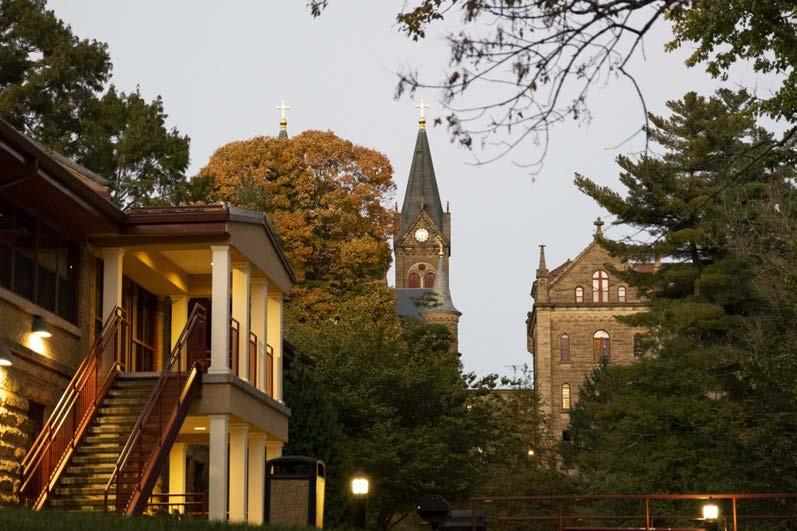
Dr. William J. Browning, O’72 (’60-65), of Ledyard, CT, has been named a Fellow of the Institute for Operations Research and the Management Sciences in recognition of his contributions, achievements and service that have advanced the profession.
Mr. Doug Brummell, GTP, of Castle Rock, CO, is part of a duo that performs “The Doug and Dave Show.” They performed a one-day version of “Mass Confusion” in Naperville, IL, in September. They use humor, songs and audience interaction to help educate people about the Catholic faith.
Fr. Jamie Dennis, T’16, (’09-16), a priest of the Diocese of Owensboro, KY, recently climbed Lassen Peak in California for the second time, although he is blind. He relied on a guide to hike with him up the 10,000-foot climb.
Sr. Suzan Foster, SSJ, SS’79 (’75-79), has retired from St. Joseph Academy in St. Augustine, FL, ending 50 years of teaching in Florida’s Catholic schools. At her retirement party, she learned that the school’s inner circle would be named “Sister Suzan Way.” For the past 25 years, she has been assistant principal and religion teacher at St. Joseph Academy.
Fr. Matt Gerlach, C’92 (’89-92) and T’96 (’92-96), was recently inducted into the Hall of Fame of his alma mater,
ALUMNI NEWS
Bishop Kelley High School in the Diocese of Tulsa, OK.
Dr. George Gonzalez, T’87 (’83-87), of Harlingen, TX, has been named a distinguished professor of Crown University International Chartered Inc.
Fr. Ronald Knott, O’70 (’64-70), and Fr. Robert Ray, SS’76, priests of the Archdiocese of Louisville, KY, led the remodeling efforts of their former parish grade school into a new St. Theresa Family Life Center. Archbishop Shelton Fabre blessed the project on October 15, 2022. It was discovered, during the planning process, that the parish was also the home parish of Martha Jane Tolton, mother of the Venerable Fr. Augustus Tolton, the nation’s first recognized black priest – himself a former slave on the path to canonization. Fr. Tolton’s grandmother, Matilda, is buried in St. Theresa Cemetery. Matilda and her daughter, Martha Jane, were two of 222 enslaved Catholics baptized in that parish in the mid-1800s. All 222 names of the former enslaved parish members are enshrined in a photo gallery in the new St. Theresa Family Life Center.
Mr. Tom Malewitz, GTP’07 (’05-07), of Louisville, KY, presented a series of Bible studies on the prophets Isaiah, Jeremiah,
Ezekiel and Daniel at St. Raphael Parish in Louisville during November.
Mr. Gary Marvin, O’70 (’58-70), of Louisville, KY, and Mr. Jay Fadgen, O’70 (59-67), of Falls Church, VA, regularly host Zoom teleconferences with 10 classmates. These “Meinrad Connection” sessions are a forum to refresh bonds formed on the Hill and discuss issues of the day, both religious and secular.
Fr. Earl Rohleder, O’63 (’51-59), a retired priest of the Diocese of Evansville, IN, now living and working in Santa Fe, NM, has published a book. Fr. Earl’s ‘Junk Art’ Over the Years showcases the many pieces of art he has created using found objects.
Mr. Ken Sicard, C’74 (’70-71), of Ferdinand, IN, was named ambassador for the 2022 Ferdinand Heimatfest. He also serves as president of the town council.
Fr. Herb Weber, O’74 (’69-74), retired on June 30, 2022, as pastor of St. John XXIII Catholic Community in Perrysburg, OH, where he started the parish in 2005.
Mr. Gregory Welch, T’99 (’86-89; ’9498); GTP’08 (’04-05, ’08), of Peoria, IL, recently achieved status as a boardcertified chaplain through the National Association of Catholic Chaplains.
New book examines life of St. Rafael Arnaiz
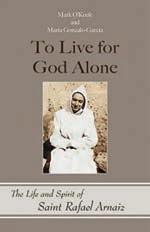
In his 14th book, Saint Meinrad monk Fr. Mark O’Keefe, OSB, and his co-author María GonzaloGarcía, OCSO, examine the life of a little-known saint, Rafael Arnaiz. To Live for God Alone: The Life and Spirit of Saint Rafael Arnaiz is published by Cistercian Publications and Liturgical Press.
“God alone” was the constant theme of St. Rafael Arnaiz (1911–1938), the expression of the search for God that
informs any monastic vocation. St. Rafael was profoundly and thoroughly a monk, even though ill health repeatedly forced him to leave the monastery, and he was never formally professed.
With his single-hearted love for Christ and for the Blessed Virgin, he faithfully walked a path of trials and suffering that matured his faith, sharpened his longing, taught him to wait and to hope in God, and opened his heart to love. To Live for God Alone invites the reader into the compelling story of Rafael’s personal journey and into his penetrating insight into the cross and the Christian vocation.
Fr. Mark is professor of moral theology at Saint Meinrad Seminary and School of Theology, where he served as presidentrector from 1996 to 2008. He is also currently resident chaplain for Carmelite nuns in Terre Haute, IN.
Sr. María is the novice director at the Trappist-Cistercian monastery of Our Lady of the Angels in Crozet, VA. She is the editor of the English translation of Saint Rafael Arnaiz’s Collected Works (Cistercian Publications and Liturgical Press, 2022).
200 Hill Drive
St. Meinrad, IN 47577
2023 Alumni Reunion scheduled for July 31-August 2
The Most Rev. J. Peter Sartain, C’74 (’71-74), who served as archbishop of the Archdiocese of Seattle from 2010 to 2019, will be the presider and homilist at the Reunion Mass on Tuesday afternoon.
Archbishop Sartain resigned from the Seattle Archdiocese due to health reasons. He had previously served as bishop of the Diocese of Joliet, IL, and before that, from 2000 to 2006, was bishop of the Diocese of Little Rock, AR.
The 95th annual Alumni Reunion will give former Saint Meinrad students the opportunity for fellowship with classmates, spiritual renewal, relaxation, and learning. The 2023 event is planned for July 31-August 2 at Saint Meinrad Archabbey.
“The Alumni Reunion is one of the biggest events on the Hill annually,” says Tim Florian, director of alumni relations, “and it is always such a blessing to see so many people gathering from different eras – all with a strong love and appreciation for Saint Meinrad and each other.”
This year’s reunion will include a golf scramble, workshops, time for prayer and socializing, and the awarding of the Distinguished Alumnus Award.
The reunion kicks off on Monday, July 31, with a golf scramble at Christmas Lake Golf Course in Santa Claus. Non-golfers will be able to attend educational or spiritual talks during the day.
The anniversary banquet will be held Monday evening, honoring the classes of 1973 (50th anniversary), 1983 (40th), 1998 (25th), 2013 (10th), and 2018 (5th).
A native of Memphis, TN, Sartain studied English before entering seminary. He received a bachelor’s degree in sacred theology from the Pontifical University of St. Thomas Aquinas in Rome in 1977 and, after his priestly ordination in 1978, returned to Rome for further studies at the Pontifical University of St. Anselmo.
At the banquet Tuesday evening, Bishop Sartain will receive the Distinguished Alumnus Award.
As details are confirmed, information about the reunion will be available on the website, http://alumni.saintmeinrad.edu, and the alumni Facebook page, www.facebook.com/SaintMeinrad Alumni.
